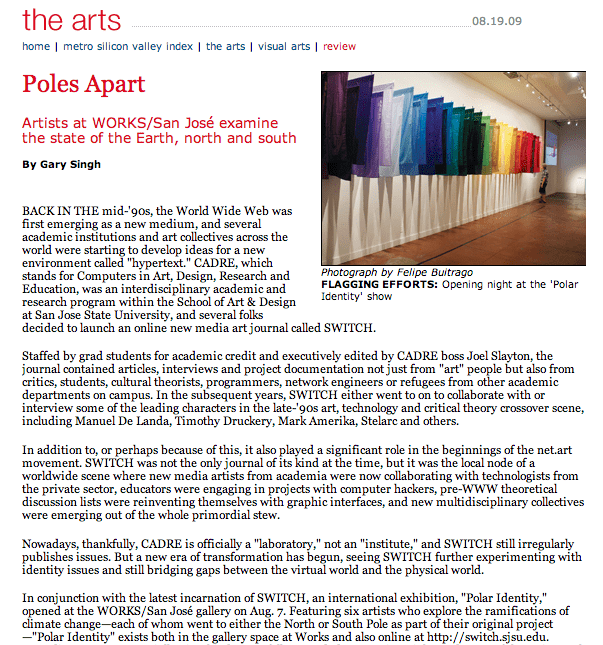MetroActive
The Arts
August 19, 2009

By Gary Singh
BACK IN THE mid-’90s, the World Wide Web was first emerging as a new medium, and several academic institutions and art collectives across the world were starting to develop ideas for a new environment called “hypertext.” CADRE, which stands for Computers in Art, Design, Research and Education, was an interdisciplinary academic and research program within the School of Art & Design at San Jose State University, and several folks decided to launch an online new media art journal called SWITCH.
Staffed by grad students for academic credit and executively edited by CADRE boss Joel Slayton, the journal contained articles, interviews and project documentation not just from “art” people but also from critics, students, cultural theorists, programmers, network engineers or refugees from other academic departments on campus. In the subsequent years, SWITCH either went to on to collaborate with or interview some of the leading characters in the late-’90s art, technology and critical theory crossover scene, including Manuel De Landa, Timothy Druckery, Mark Amerika, Stelarc and others.
In addition to, or perhaps because of this, it also played a significant role in the beginnings of the net.art movement. SWITCH was not the only journal of its kind at the time, but it was the local node of a worldwide scene where new media artists from academia were now collaborating with technologists from the private sector, educators were engaging in projects with computer hackers, pre-WWW theoretical discussion lists were reinventing themselves with graphic interfaces, and new multidisciplinary collectives were emerging out of the whole primordial stew.
Nowadays, thankfully, CADRE is officially a “laboratory,” not an “institute,” and SWITCH still irregularly publishes issues. But a new era of transformation has begun, seeing SWITCH further experimenting with identity issues and still bridging gaps between the virtual world and the physical world.
In conjunction with the latest incarnation of SWITCH, an international exhibition, “Polar Identity,” opened at the WORKS/San José gallery on Aug. 7. Featuring six artists who explore the ramifications of climate change—each of whom went to either the North or South Pole as part of their original project—”Polar Identity” exists both in the gallery space at Works and also online at http://switch.sjsu.edu. According to curator Danielle Siembieda, 900 folks attended on opening night, and some of the artists took part in an online chat about their work.
CADRE originally put out the open call for works for “Polar Identity” earlier this year, and six international artists were accepted to be part of the show. The $1,000 first prize went to Andrea Polli, a digital-media artist and director of the Interdisciplinary Film and Digital Media Program at the University of New Mexico. Polli, who also exhibited at 01SJ last year, spent seven weeks in Antarctica on a National Science Foundation–funded residency. For Sonic Antarctica, she recorded material from several areas including “the Dry Valleys, the driest and largest relatively ice-free area on the continent, completely devoid of terrestrial vegetation; and the geographic South Pole, the center of a featureless flat, white expanse on top of ice nearly 9 miles thick.” At WORKS, one sees the three-channel video with stereo sound version of the project, which is also a radio broadcast, live performance and audio CD on the Grunrecorder label.
The $500 runner-up purse went to Xavier Cortada. Using a moving Antarctic ice sheet to mark the passage of time, Cortada installed 51 flags along a half-kilometer stretch of the ice sheet, the flags 10 meters apart and marking the spot where the geographic South Pole stood during each year since 1956, when the continent became permanently inhabited. Both documentation and flags hang from the wall in the gallery.
Other artists exploring the poles are Jerome Gueneau and Catherine Rannou, Andrea Juan, Erika Blumenfeld and Montreal-based Phil Boissonnet. The jurors include surveillance artist Hasan Elahi, new-media artist Robin Lasser and the French writer/curator Annick Bureaud. “The idea is that if people see this physically, they’ll go look at SWITCH virtually,” Siembieda said. “And if people see SWITCH virtually, they’ll come to WORKS to see this physically.”
POLAR IDENTITY shows through Sept. 11 at WORKS/San José, 451 S. First St., San Jose. (408.286.6800)